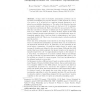Free Online Productivity Tools
i2Speak
i2Symbol
i2OCR
iTex2Img
iWeb2Print
iWeb2Shot
i2Type
iPdf2Split
iPdf2Merge
i2Bopomofo
i2Arabic
i2Style
i2Image
i2PDF
iLatex2Rtf
Sci2ools
104
Voted
APPROX
2005
Springer
2005
Springer
Sampling Bounds for Stochastic Optimization
A large class of stochastic optimization problems can be modeled as minimizing an objective function f that depends on a choice of a vector x ∈ X, as well as on a random external parameter ω ∈ Ω given by a probability distribution π. The value of the objective function is a random variable and often the goal is to find an x ∈ X to minimize the expected cost Eω[fω(x)]. Each ω is referred to as a scenario. We consider the case when Ω is large or infinite and we are allowed to sample from π in a black-box fashion. A common method, known as the SAA method (sample average approximation), is to pick sufficiently many independent samples from π and use them to approximate π and correspondingly Eω[fω(x)]. This is one of several scenario reduction methods used in practice. There has been substantial recent interest in two-stage stochastic versions of combinatorial optimization problems which can be modeled by the framework described above. In particular, we are interested ...
Related Content
| Added | 26 Jun 2010 |
| Updated | 26 Jun 2010 |
| Type | Conference |
| Year | 2005 |
| Where | APPROX |
| Authors | Moses Charikar, Chandra Chekuri, Martin Pál |
Comments (0)

